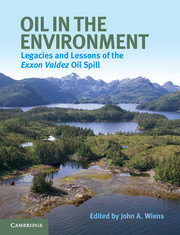Book contents
- Frontmatter
- Contents
- List of contributors
- Use of acronyms
- Acknowledgments
- A bibliographic note
- Prologue
- Part I Introduction and background
- Part II Oil in the environment
- Part III Biological effects
- 9 Cytochrome P450 1A (CYP1A) as a biomarker in oil spill assessments
- 10 Assessing effects and recovery from environmental accidents
- 11 Shoreline biota
- 12 Oiling effects on pink salmon
- 13 Pacific herring
- 14 Oil and marine birds in a variable environment
- 15 Sea otters: trying to see the forest for the trees since the Exxon Valdez
- Part IV Assessing oil spill effects and ecological recovery
- Part V Conclusions
- Index
- References
15 - Sea otters: trying to see the forest for the trees since the Exxon Valdez
Published online by Cambridge University Press: 05 July 2013
- Frontmatter
- Contents
- List of contributors
- Use of acronyms
- Acknowledgments
- A bibliographic note
- Prologue
- Part I Introduction and background
- Part II Oil in the environment
- Part III Biological effects
- 9 Cytochrome P450 1A (CYP1A) as a biomarker in oil spill assessments
- 10 Assessing effects and recovery from environmental accidents
- 11 Shoreline biota
- 12 Oiling effects on pink salmon
- 13 Pacific herring
- 14 Oil and marine birds in a variable environment
- 15 Sea otters: trying to see the forest for the trees since the Exxon Valdez
- Part IV Assessing oil spill effects and ecological recovery
- Part V Conclusions
- Index
- References
Summary
Introduction
The Exxon Valdez oil spill generated enormous public and scientific attention on sea otters (Enhydra lutris). Photos of oil-covered sea otters hauled out on beaches or collected in boats frequently appeared in the media and in government reports, making it one of the most notable “poster species” of this spill (Batten, 1990). Rice et al. (2007, p. 450) commented, that “Perhaps our most persistent collective memory of the oil spill is the dead and dying sea otters.” A major report, Legacy of an Oil Spill 20 Years after Exxon Valdez, featured sea otters on the cover and used this species as the predominant case study (Exxon Valdez Oil Spill Trustee Council, 2009).
Attention to sea otters was fueled by their charismatic nature and appearance, combined with the fact that no mammal suffered greater spill-related mortality. Given the large number of otters that died (or were not born) as an immediate or long-term result of the spill, the significance of this species in terms of natural resource damage assessment and public relations was enormous. It was argued, for example, that each otter killed in the spill was “worth” at least $80 000, the minimal cost to Exxon for each otter that was captured, cleaned, and rehabilitated (Estes, 1991).
- Type
- Chapter
- Information
- Oil in the EnvironmentLegacies and Lessons of the Exxon Valdez Oil Spill, pp. 348 - 379Publisher: Cambridge University PressPrint publication year: 2013
References
- 2
- Cited by

